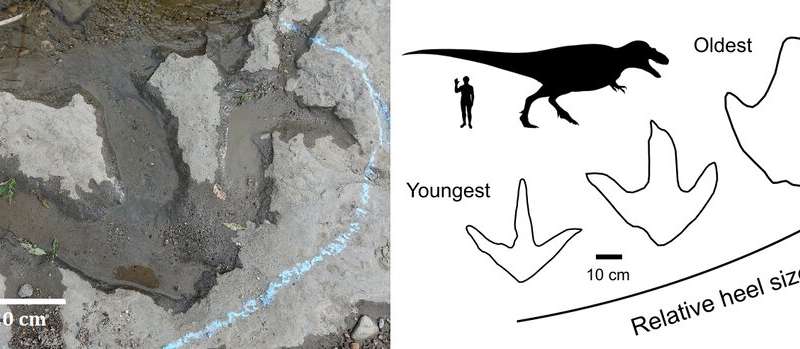Fat-footed tyrannosaur parents couldn't keep up with their skinnier offspring, fossil footprints reveal

Tyrannosaurus rex is perhaps the most famous of all dinosaurs. It and its closest kin, a group referred to as "tyrannosaurs," have been embedded in popular culture as powerful and mobile predators.
Consider the below scene from the 1993 blockbuster Jurassic Park; an adult T. rex chases down a speeding Jeep—much to the thrill of the audience.
But Jeeps and fanciful theme parks aside, are these depictions realistic?
Our research, published today in the Journal of Vertebrate Paleontology, shows while young tyrannosaurs may have indeed been the vision of wrath depicted above, they likely became broader-footed, bulky and less mobile in adulthood.
A new perspective
Previous arguments about the way tyrannosaurs did (or didn't) run either focused on their bones, or relied on computer models to simulate their running abilities.
Apart from being smaller, the skeletons of young tyrannosaurs are also more lightly built than their bulkier parents, which suggests they were probably faster and more nimble for their body size. Juveniles tended to have relatively longer legs and smaller skulls, and weighed much less than a fully grown adult.
In fact, the volume of leg muscles needed to sustain a fast running pace in a six-ton adult T. rex would have probably been biologically impossible. This would require the dinosaur having as much as 86% of its total body weight just as leg muscle!
However, skeletons only represent part of the story. Fossilized footprints provide a unique snapshot in time of how an animal (or species) moved about its environment—one not provided by skeletons.
Fossilized footprints are a fleshed-out image of the feet as they once appeared in real life, with the soft parts still intact.
In 2015 and 2018, our team discovered a new collection of tyrannosaur footprints in rocks at a lonely outpost in western Canada, which we introduce for the first time in our new paper.
These footprints presented a unique opportunity to study how tyrannosaurs' foot shapes changed from youth to adulthood. If their relative mobility decreased as they grew—as was previously hypothesized from studying their skeletons—then we'd expect this to be expressed in foot shape, too.
Younger and swifter animals would have more slender feet, whereas older individuals would have bulkier feet, less suited for speed and agility.
Tracking ancient footprints through bear country
The tyrannosaur tracks we found remain preserved in a wilderness area near Grande Prairie in Northwestern Alberta, Canada. The region is known for its bitter cold winters, which causes the rivers to flood in spring as snow-melt rolls off the nearby Rocky Mountains.
The footprints themselves are preserved along a bank of the Redwillow River, surrounded by Boreal forest, which today is home to wildlife including brown bears, black bears and wolves.

Thankfully our close encounters were largely with deer, although swarms of mosquitoes were a constant nuisance.
Tyrannosaur footprints in this area can be identified by the presence of three long and narrow toes, often with sharp, pointed claw marks. We found up to ten footprints, all about 72 million years old, ranging from 30 to 62 centimeters in length.
Although no bones were discovered, the footprints may have belonged to Albertosaurus. This tyrannosaur lived in Alberta at that time and was an earlier and smaller relative of T. rex.
My, what big heels you have!
Using a method called geometric morphometrics, we analyzed the best tyrannosaur footprints from our collection of tracks, along with previously discovered footprints.
This method mathematically removes the effect of overall size difference between each footprint while examining important differences in footprint shape.
Applied to our samples, we found the main difference across all footprints was the surface area and width of the heel relative to the footprint's length.
Larger prints had proportionally larger heels while smaller tracks had narrower, smaller heels.

This difference likely relates to the imposing size of an adult tyrannosaur, or specifically an adult Albertosaurus, which may have weighed between 1,300 and 2,200 kg.
A wider and more fleshy heel probably helped adults maintain balance and support increased weight, but likely came at the expense of speed and agility.
Our work on footprints serves to support the hypothesis that as tyrannosaurs grew they underwent a shift from quick, sprightly juveniles to slower, heavy-set adults.
Slowed down by old age
Would this have been a problem for catching food as an adult tyrannosaur? Probably not. The large four-legged herbivores they hunted, such as Edmontosaurus regalis (which weighed about 4,000kg), were probably even slower.
So what about that chase scene from Jurassic Park?
Well, we still can't be certain exactly how fast an adult T. rex could run. But we can say heavier and bulkier adults were probably slower for their body size than more slender juveniles.
Perhaps it should have been a juvenile tyrannosaur chasing that Jeep instead. Although this wouldn't have been quite as scary.
More information:
Exploring possible ontogenetic trajectories in tyrannosaurids using tracks from the Wapiti Formation (upper Campanian) of Alberta, Canada, Journal of Vertebrate Paleontology (2021). www.tandfonline.com/doi/full/1 … 2724634.2021.1878201
This article is republished from The Conversation under a Creative Commons license. Read the original article.![]() This story is part of Science X Dialog, where researchers can report findings from their published research articles. Visit this page for information about ScienceX Dialog and how to participate.
This story is part of Science X Dialog, where researchers can report findings from their published research articles. Visit this page for information about ScienceX Dialog and how to participate.